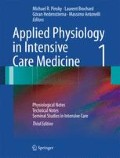Abstract
Background: Inappropriate selection of tidal volume and rate on mechanical ventilators in patients with reduced lung volume may cause lung damage. In spite of this rather recent insight, the optimal breath pattern and the relative importance of elevating end-expiratory lung volume (EELV) are still debated. A recent hypothesis is that lung injury is caused by excessive stress and strain. This paper elaborates on that hypothesis and proposes a new approach to optimizing the breath pattern. Methods: An index to quantify the impact of positive pressure ventilation on the lungs is defined (Stress–Strain Index, SSI) and calculated as a function of the breath pattern (tidal volume Vt and respiratory rate f) for five different levels of EELV. The breath pattern at which SSI is minimal (mSSI strategy) was compared with three other strategies: the ‘‘6 ml/kg Vt,’’minimal work of breathing and minimal force to breathe, for the different EELV levels. Results: In the mathematical analysis, SSI was mainly determined by EELV and was much higher with low EELV. For each EELV level, a distinct minimum of SSI was found, defined by a particular Vt - f combination. The mSSI strategy yielded lower Vt and higher f (0.252 l and 39 b/min) as compared to the ‘‘6 ml/kg Vt’’ strategy (0.420 l and 17 b/min). Conclusion: The EELV is the main determinant of the SSI. For a given EELV, the SSI can be minimized by an optimal Vt - f combination.
Access this chapter
Tax calculation will be finalised at checkout
Purchases are for personal use only
Preview
Unable to display preview. Download preview PDF.
References
Otis AB, Fenn WO, Rahn H. Mechanics of breathing in man. J Appl Physiol. 1950;2:592–607.
Mead J. Mechanical properties of lungs. Physiol Rev. 1961;41:281–330.
Pontoppidan H, Geffin B, Lowenstein E. Acute respiratory failure in the adult. N Engl J Med. 1972;19:799–806.
The Acute Respiratory Distress Syndrome Network. Ventilation with lower tidal volumes as compared with traditional tidal volumes for acute lung injury and the acute respiratory distress syndrome. N Engl J Med. 2000;342:1301–1308.
Chiumello D, Carlesso E, Cadringher P, Caironi P, Valenza F, Polli F, Tallarini F, Cozzi P, Cressoni M, Colombo A, Marini JJ, Gattinoni L. Lung stress and strain during mechanical ventilation of the acute respiratory distress syndrome. Am J Respir Crit Care Med. 2008;178:346–355.
Gattinoni L, Carlesso E, Cadringher P, Valenza F, Vagginelli F, Chiumello D. Physical and biological triggers of ventilator-induced lung injury and its prevention. Eur Respir J. 2003;47:15s–25s.
Wilson TA (1986) Solid mechanics. In: American Physiological Society (ed) Handbook of physiology: a critical comprehensive presentation of physiological knowledge and concepts. Waverly Press, Baltimore, pp 35–39
Vlahakis NE, Hubmayr RD. Cellular stress failure in ventilatorinjured lungs. Am J Respir Crit Care Med. 2005;171:1328–1342.
Kacmarek RM, Kallet RH. Respiratory controversies in the critical care setting. Should recruitment maneuvers be used in the management of ALI and ARDS? Respir Care. 2007;52:622–631.
Talmor D, Sarge T, Malhotra A, O’Donnell CR, Ritz R, Lisbon A, Novack V, Loring SH. Mechanical ventilation guided by esophageal pressure in acute lung injury. N Engl J Med. 2008;359:2095–2104.
Author information
Authors and Affiliations
Editor information
Editors and Affiliations
Rights and permissions
Copyright information
© 2012 Springer-Verlag Berlin Heidelberg
About this chapter
Cite this chapter
Brunner, J.X., Wysocki, M. (2012). Is there an optimal breath pattern to minimize stress and strain during mechanical ventilation?. In: Pinsky, M., Brochard, L., Hedenstierna, G., Antonelli, M. (eds) Applied Physiology in Intensive Care Medicine 1. Springer, Berlin, Heidelberg. https://doi.org/10.1007/978-3-642-28270-6_7
Download citation
DOI: https://doi.org/10.1007/978-3-642-28270-6_7
Published:
Publisher Name: Springer, Berlin, Heidelberg
Print ISBN: 978-3-642-28269-0
Online ISBN: 978-3-642-28270-6
eBook Packages: MedicineMedicine (R0)

